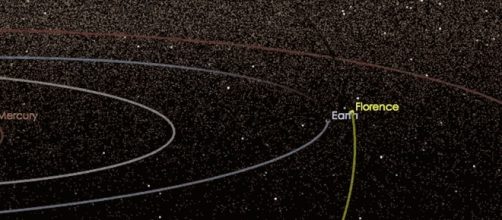A three mile-wide wide asteroid passed by the Earth last Friday (Sept. 1, 2017) accompanied by two moons. Astronomers estimate that each moon could measure up to 1,000 feet in diameter.
The non-fatal near-Earth object called “Florence” flew about 4.4 miles away from the planet. That’s 18 times the distance of the moon from the Earth. The said asteroid last approached the planet in 1890. According to astronomers, the next close visit will occur in 2500.
Asteroid and its moon
Various organizations including NASA and the European Space Agency (ESA) observed the asteroid.
During the documentation process, they discovered the presence of two moons orbiting the space rock.
Although the humongous asteroid did not pose any threat, NASA said it was the nearest flyby a 3-mile asteroid made to the planet ever since they started tracking near-Earth objects. Radar images of the space rock gave NASA new information about the asteroid including its two accompanying satellites. This is the first time this generation was given an opportunity to observe Florence using ground-based radar observatories.
According to NASA, about two-thirds of identified asteroids have its own moon. They have long been suspecting that Florence has its own satellite but have no way of confirming it until the close approach last Friday.
To their surprise, it indeed has not one but two moons.
Although radar images cannot accurately measure the size of the moons, astronomers from NASA’s Center for Near-Earth Object Studies (CNEOS) believe that the moon size ranges from 300 to 1000 feet in diameter. The agency is also unsure about the orbiting time for both satellites but estimates that the inner moon could take 8 hours to complete an orbit while the outer moon might take 22 hours. With the newly acquired data, astronomers can now say that Florence’s innermost moon has the shortest orbital period among the moons of 60 identified asteroids.
Detailed images of the Florence
Aside from its moons, radar images revealed detailed information about the physical attributes of the near-Earth object.
From the images, astronomers were able to identify ridges and one visibly huge crater on the asteroid’s equator making its surface uneven.
NASA used its 70-meter antenna at the Goldstone Deep Space Communications Complex in California and the National Science Foundation’s Arecibo Observatory located in Puerto Rico to study the asteroid.
Aside from being the biggest asteroid to make the closest approach to the planet, Florence moves slower compared to other space rocks. In fact, it was visible to anyone with a telescope or binoculars during its flyby.


